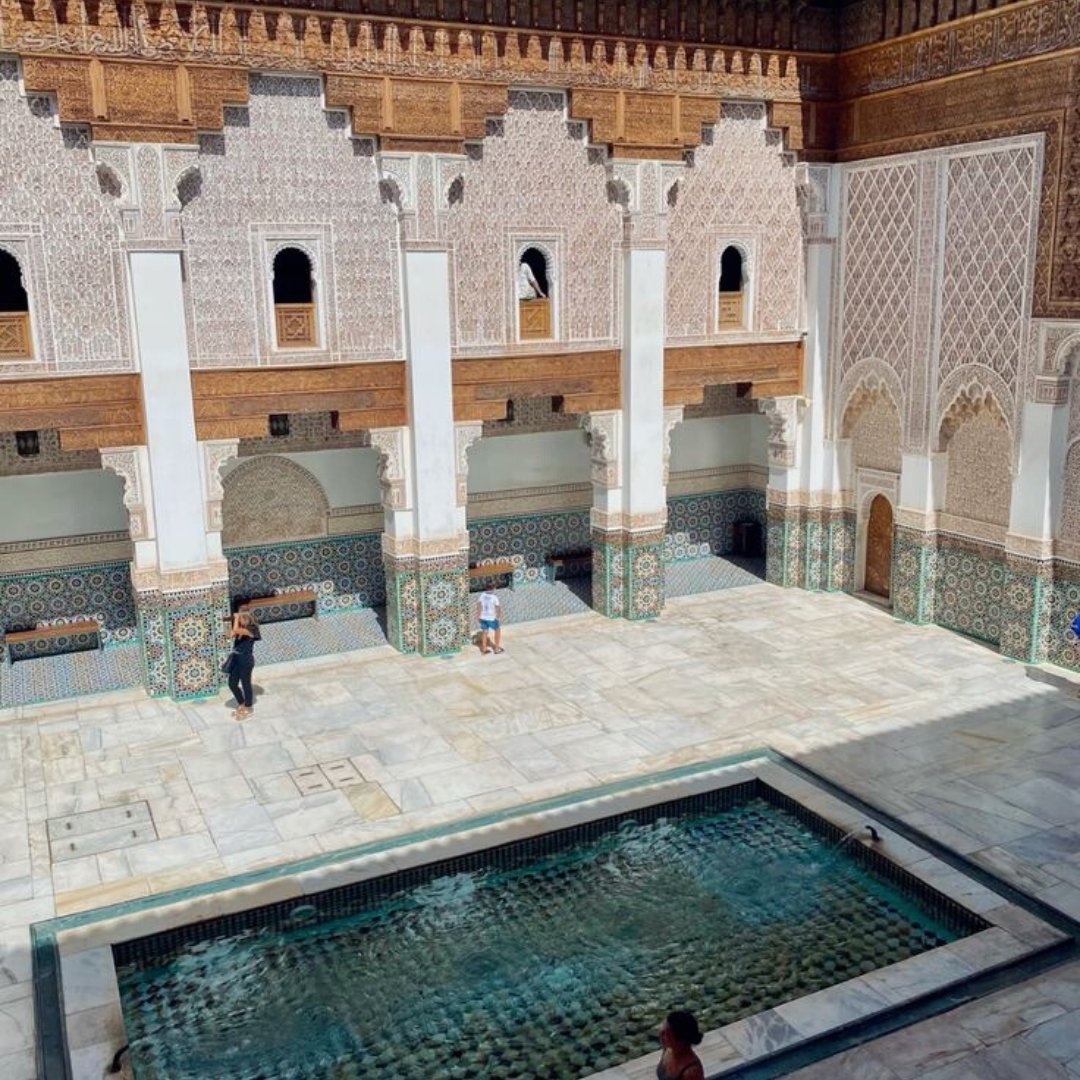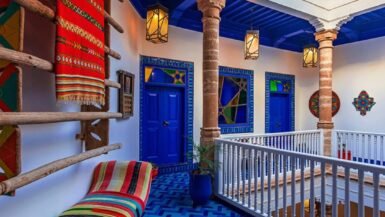Ben Youssef Madrasa in Marrakech is a true gem of Islamic architecture and a testament to the city’s history as a center of knowledge and spirituality. It is one of the most important historical monuments in the Red City, attracting thousands of visitors each year to explore the beauty of its decorations and unique architectural design. This comprehensive guide aims to present the rich history of Ben Youssef Madrasa, its remarkable architecture, its role as the largest Quranic school in Morocco, as well as provide practical information for visiting and enjoying its peaceful atmosphere, which contrasts with the bustle of Marrakech’s neighboring souks.
History of Ben Youssef Madrasa: A Center of Learning Through the Ages
Ben Youssef Madrasa has undergone important historical developments, from its initial foundation to the great reconstruction we know today, making it a prominent educational center in Morocco’s history.
The Initial Foundation (Almoravid Period)
Ben Youssef Madrasa is linked by name to the adjacent mosque, the Ben Youssef Mosque, which dates back to the era of Almoravid Sultan Ali ibn Youssef (ruled 1106-1142). According to historical sources, particularly al-Ifrani, the first madrasa on this site was founded during the Marinid dynasty by Sultan Abu al-Hassan (ruled 1331-1348). This dynasty, known for its promotion of arts and literature, ruled from Fez during the 13th to 15th centuries and was responsible for constructing many schools throughout Morocco.
The Great Reconstruction in the Saadian Era
The madrasa underwent a radical change during the reign of Saadian Sultan Abdallah al-Ghalib (ruled 1557-1574), who ordered its complete reconstruction. Work likely began as soon as he assumed power and was completed in 1564-1565 CE (972 AH), as recorded in an inscription inside the madrasa. The construction followed the architectural style established during the earlier Marinid period, but it was distinguished by its large size, becoming the largest madrasa in the entire Maghreb region.
The Role of the Madrasa as a Center for Study and Residence
Ben Youssef Madrasa was a prestigious educational institution combining teaching and accommodation. At its height, it accommodated more than 800 students from all regions of Morocco and beyond. Students studied Islamic sciences, Maliki jurisprudence, the Quran, and Arabic language. The madrasa contained approximately 130 student rooms distributed over the ground and upper floors around the central courtyard and six small courtyards.
The Closure of the Madrasa and Its Transformation into a Tourist Monument
The madrasa continued to fulfill its educational role for many centuries until it was closed as an active educational institution in 1960. Subsequently, it was renovated and reopened to the public as a historical site in 1982. The madrasa underwent restoration work again starting in November 2018 and was reopened to the public in April 2022, continuing to attract thousands of tourists annually as one of the most important historical monuments in Marrakech.
Architecture of Ben Youssef Madrasa: Amazing Artistic Details
The architecture of Ben Youssef Madrasa is a perfect example of Saadian architectural art, characterized by its rich decorative details that attract attention and reflect a high level of craftsmanship and creativity.
General Layout and Design
Ben Youssef Madrasa follows the traditional layout of Islamic schools, occupying an almost square space measuring 40 × 43 meters. It is accessed through a single entrance from the street, in front of which is a square vault sculpted with muqarnas. From the entrance, a narrow corridor leads to a reception room that provides access on one side to the central courtyard. This carefully designed entry process, as in many Islamic buildings, is intended to inspire admiration and amazement at the sudden opening to the main courtyard.
The Central Courtyard: The Heart of the Madrasa
The central courtyard of Ben Youssef Madrasa is one of the most beautiful courtyards in Islamic architecture, surrounded by galleries on the east and west sides, and student rooms on the upper and lower floors. The courtyard features a central water basin that reflects the surrounding architecture and adds a touch of calm and contemplation to the place. The splendor of the architectural design is manifested in the courtyard through the perfect balance between its different components and the harmony among the decorative elements.
The Student Residence Cells
Ben Youssef Madrasa includes approximately 130 small rooms that were designated for student accommodation, distributed around the first and second floors of the central courtyard. The dormitories are also arranged around a series of six small courtyards (three in the northeast wing, three in the southwest wing) that open on both levels from these corridors. These rooms are characterized by their simple and modest design, reflecting the austere life that students led at that time. Today, visitors can peek inside some of these rooms to discover the living conditions of students in the past.
The Prayer Hall and Mihrab
The madrasa has a prayer hall located next to the main courtyard. This hall is characterized by a beautifully decorated mihrab, a niche in the wall indicating the direction of the Qibla. The mihrab is adorned with detailed stucco patterns including decorative motifs such as “darj wa ktaf” and Quranic inscriptions in Kufic calligraphy. This hall served as a spiritual center for students, where they could perform their prayers and meditate.
The Decorations and Artistic Details (Zellij, Stucco, Wood)
The rich and diverse decorations are among the most important features of Ben Youssef Madrasa, demonstrating the skill of Moroccan craftsmen in the Saadian era. These decorations vary between:
- Zellij: These are colorful geometric mosaics that particularly cover the lower walls of the madrasa, forming complex and harmonious geometric patterns.
- Carved Stucco: These are detailed plaster carvings that adorn the upper walls and arches, characterized by floral and geometric designs of great precision.
- Carved Wood: Beautifully carved cedarwood was used for ceilings, cornices, and screens. Artistic expertise is manifested in the inlay and carving of the wood.
- Arabic Calligraphy: Calligraphic inscriptions are spread throughout the madrasa, including Quranic verses, historical dates, and religious phrases, written in various Arabic calligraphic styles such as Kufic.
These diverse decorations reflect a high level of craftsmanship and a variety of patterns, making the madrasa a living museum of Moroccan Islamic art.
Importance of Ben Youssef Madrasa: A Scientific and Architectural Legacy
The importance of Ben Youssef Madrasa lies in several aspects that make it a prominent monument in the history of Morocco and Islamic civilization:
- It was the largest Islamic educational center in Morocco, playing a central role in the dissemination of Islamic sciences and knowledge.
- It represents a remarkable example and masterpiece of Saadian architecture, reflecting the architectural and artistic evolution of this important period in Moroccan history.
- It testifies to the historical tradition of providing education and accommodation to students, reflecting the interest in science in Islamic civilization.
- It symbolizes the intellectual and artistic achievements of the Saadian era, showing the level of cultural development reached by Morocco during that period.
- It constitutes an essential element of UNESCO World Heritage sites in the old city of Marrakech, enhancing its universal value as human heritage.
Visiting Ben Youssef Madrasa: A Practical Guide
Visiting Ben Youssef Madrasa is an enjoyable experience for discovering the beauty of architecture and history. Here is a practical guide to help you in your visit to fully enjoy this unique historical monument.
Location of the Madrasa and How to Get There
Ben Youssef Madrasa is located in the northern part of the old city of Marrakech (the Medina). It is close to the Ben Youssef Mosque, the Almoravid Koubba, and the Marrakech Museum. It can be accessed on foot from Jemaa el-Fna square, taking about 10-15 minutes walking through the souks, or by taxi to a nearby point and then walking through the alleys leading to it. You will find signs guiding you to the site, and you can also ask local residents who will be happy to direct you.
Opening Hours of Ben Youssef Madrasa
Ben Youssef Madrasa is open to visitors from 9:00 AM to 7:00 PM, seven days a week. During the month of Ramadan, the opening hours change to 10:00 AM to 4:00 PM. It is advisable to arrive early in the morning or late in the afternoon to avoid crowds and enjoy the soft light that highlights the architectural details.
Entrance Fees to the Madrasa
The standard entrance ticket price for foreign adults is 50 Moroccan dirhams (about 5 US dollars), while the cost of the ticket for children (under 12 years) is 10 Moroccan dirhams (about 1 US dollar). If you have a Moroccan ID card, the entrance fee is only 20 dirhams. For groups of more than 20 people, a reduced rate of 30 dirhams per person can be obtained. You can purchase tickets directly upon arrival.
What to Expect to See in the Madrasa
During your visit to Ben Youssef Madrasa, you will follow the typical visitor route: starting with entering the courtyard and being amazed by its beauty, exploring the surrounding student rooms (generally viewed from the entrances), and visiting the prayer hall. It is important to take time to admire the detailed decorations (zellij, stucco, wood). The visit generally takes between 45 minutes and one hour. You will find information panels scattered throughout the madrasa, so take your time to read them to gain a deeper understanding of the history and importance of the place.
Visiting Rules and Behavior
It is recommended to dress modestly (covering shoulders and knees) out of respect for its historical religious and educational nature. Maintain a quiet and respectful atmosphere inside the madrasa. There is no strict dress code, but respectful clothing should be worn when visiting. Bring enough local money to pay the entrance fee, as credit cards may not be accepted at all times.
Landmarks Near Ben Youssef Madrasa
Around Ben Youssef Madrasa is a set of important historical and cultural monuments that can be visited during your stay in the area:
Ben Youssef Mosque
This is the mosque historically linked to the madrasa, dating back to the Almoravid era. Please note that entry to the mosque is restricted to Muslims only.
The Almoravid Koubba
This is a small but important historical monument located near the madrasa, considered the oldest architectural structure in Marrakech, dating back to the 12th century.
Marrakech Museum
Usually located near the madrasa in the beautiful Dar el Menebhi palace, it houses a collection of artistic and historical pieces reflecting the culture and history of the city.
The Souks of Marrakech
The madrasa is located within or at the edge of the northern souk area, where you can enjoy the traditional shopping experience and discover authentic Moroccan crafts and products.
Conclusion: Ben Youssef Madrasa.. A Journey Through History and Architecture in Marrakech
Ben Youssef Madrasa remains a witness to the greatness of Islamic civilization in Morocco, blending architectural beauty and historical importance. It is a place to step back in time, admire the impressive architecture, and appreciate its history as a center of learning. Its exceptional beauty and the meticulous details of its decorations make it a must-visit destination in Marrakech.
We invite you to visit Ben Youssef Madrasa and take the time to admire its meticulous details, and share your impressions or photos with us. Enjoy your journey through time in this unique architectural masterpiece that is one of the most beautiful achievements of Moroccan civilization throughout the ages.






Leave a reply